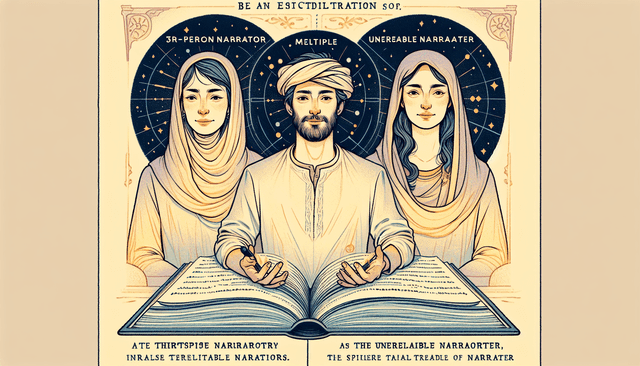Table of Contents
Have you ever found yourself tangled in a story, wondering who’s really telling it? You’re not alone! The type of narrator can make or break your reading experience, leading to diverse emotional connections and interpretations. It’s fascinating how a single story can feel completely different depending on who shares it.
If you stick around, I promise you’ll uncover the various types of narrators in literature and how they shape the plot. From first-person accounts that draw you in, to the intriguing second-person narratives, there’s a lot to explore.
We’ll dive into each narrator type, revealing their unique quirks and impacts on storytelling. By the end, you’ll be equipped to appreciate and choose the right narrator for your own tales!
Key Takeaways
- Narrators are essential in shaping how stories are experienced and understood.
- First-person narrators provide intimate insights but can be biased.
- Second-person narrators engage readers by making them feel part of the story.
- Third-person narrators can vary from limited perspectives to omniscient views, offering flexibility in storytelling.
- Multiple narrators enrich plots by showcasing different viewpoints.
- An unreliable narrator adds intrigue, encouraging readers to question the truth.
- Choosing the right narrator can enhance the emotional tone and theme of your story.
- Experimenting with narrators can lead to surprising storytelling outcomes.

1. Understanding the Types of Narrators in Literature
Narrators are like the guides of a story, shaping how readers experience it. They tell us not just what happens but how it feels, influencing our emotional journey through the narrative. Understanding the different types of narrators can enhance your storytelling and give you tools to engage your audience more effectively.
There are several types of narrators, including first-person, second-person, third-person, and even multiple perspectives. Each type brings its own flavor to the story. Exploring these types can be a fun journey that opens up new ways to tell your story and connect with readers.
2. First-Person Narrator
So, what exactly is a first-person narrator? It’s a narrator who tells the story from their own perspective, using pronouns like “I” and “me.” This style immerses the reader into the narrator’s mind, making for a deeply personal experience.
An iconic example is J.D. Salinger’s The Catcher in the Rye, where Holden Caulfield’s distinct voice gives readers a raw insight into his thoughts and emotions. If you’re thinking of using a first-person narrator, try to get their voice right. Make it authentic and consistent throughout your writing.
To make the first-person perspective work, focus on the character’s unique worldview. They should interpret events and relationships based on their experiences, keeping it real and relatable. It can be powerful when your character’s biases and limitations are clear, making readers question the reliability of their perspective.
3. Second-Person Narrator
Second-person narrators, while less common, can create a unique interaction with the reader by using the “you” pronoun. This perspective invites readers directly into the story, making them feel as though they are part of the narrative. A great example is Joseph O’Connor’s Ghost Light, which employs this technique effectively.
Using second-person narration can be tricky, so here are a couple of tips: keep your focus tight and ensure the “you” feels familiar to the reader. Start by placing them in relatable situations that draw them into the emotional heartbeat of the story.
This perspective works wonders in engaging the audience during critical moments, so consider using it strategically. It might not be suitable for every scene, but when used effectively, it can lead to a powerful reading experience.

4. Third-Person Narrator
The third-person narrator tells the story from an outside perspective, using pronouns like “he,” “she,” or “they.” This type of narration allows for more versatility in storytelling. There are also subtypes like the objective narrator, who only reports external actions, and the omniscient narrator, who knows everything about every character.
J.K. Rowling’s Harry Potter series features a limited third-person narrator, giving insights mostly into Harry’s thoughts and feelings while still allowing for a broader viewpoint.
When using a third-person narrator, it’s important to decide how much the narrator knows. Are they all-knowing, or are they limited to the thoughts of just one character? This choice significantly impacts how the reader connects with the story.
For example, George R.R. Martin’s A Song of Ice and Fire series uses multiple third-person limited perspectives, allowing the reader to explore different characters’ opinions and backgrounds.
Using the right third-person narrative style can provide depth and complexity while maintaining an emotional connection with readers.
5. Multiple Narrators
Multiple narrators can add layers to a story by providing various perspectives and interpretations. This technique can enrich the narrative by showcasing conflicting opinions or contrasting experiences.
Consider how the book The Sound and the Fury by William Faulkner uses differing view points to paint a more complex world. Each narrator presents their own version of events, creating a tapestry of experiences.
One effective way to employ multiple narrators is to assign each one a unique voice and perspective. This helps differentiate them in your readers’ minds, making each chapter or section feel fresh.
Be mindful of pacing; jumping between narrators can be jarring if not handled carefully. A well-structured approach can make the transitions seamless and engaging.
6. Unreliable Narrator
An unreliable narrator is a storyteller whose credibility is compromised. This technique invites readers to question what they’re being told, adding an element of intrigue.
Modern and postmodern literature often employs unreliable narrators. For instance, in Michel Houellebecq’s Les Particules Élémentaires, the narrator’s skewed perspective prompts readers to critically engage with the text.
To write an unreliable narrator, you might introduce contradictions in their story or have them withhold critical information, leading readers to draw different conclusions.
This narrative device can heighten suspense and provoke thought, making it especially appealing for genres like thrillers or psychological dramas.
7. Choosing the Right Narrator for Your Story
When deciding on a narrator for your story, consider the emotional tone and thematic elements you wish to convey. Different narrators lend themselves well to different kinds of storytelling.
Think about your main character’s perspective and whether a first-person viewpoint would highlight their emotions or a third-person point of view might add depth.
Experimenting with different narrators can bring surprising results; try writing a scene from multiple perspectives to discover which one resonates most with the story.
Also, consider your audience. Some readers prefer the intimacy of first-person narratives, while others appreciate the broader scope of third-person storytelling.
Ultimately, choose the narrator that best enhances the story you want to tell.
8. Conclusion: The Impact of Narrators on Literature
Narrators play a crucial role in shaping how stories are perceived and understood. They can create emotional connections, establish tension, and drive the plot forward.
Understanding the types of narrators can help writers make informed choices that elevate their narrative style.
Whether it’s a biased first-person account or the distant observation of an omniscient narrator, the choice shapes the reader’s engagement and connection with the story.
As you craft your narrative, consider experimenting with different options to unlock new layers of meaning and experience for your readers.
For more insights into narrative techniques and storytelling, you might find valuable ideas in articles like how to publish without an agent or explore creative prompts found in winter writing prompts.
FAQs
The main types of narrators include first-person, second-person, and third-person narrators. Additionally, there can be multiple narrators and unreliable narrators, each impacting the storytelling and reader’s experience differently.
A first-person narrator tells the story from their perspective using “I” or “we,” providing direct insight into their thoughts and feelings, creating a personal connection with readers compared to other narrative styles.
An unreliable narrator creates suspense and intrigue by presenting a biased or distorted version of events. This challenges readers to question the truth and engage more deeply with the narrative, often leading to surprising twists.
Consider the story’s perspective, themes, and emotional depth. The right narrator should enhance character development and influence how readers perceive the plot, ensuring alignment with your narrative goals.



